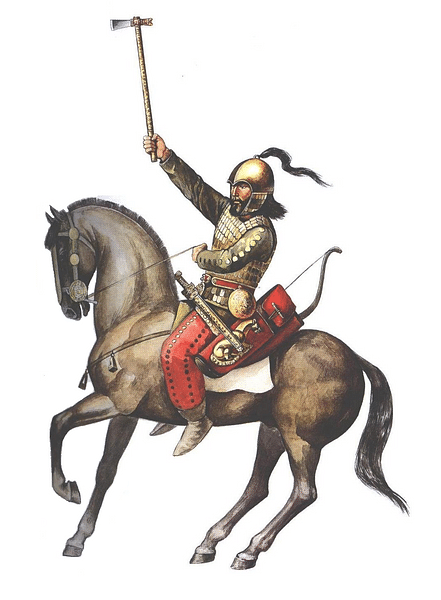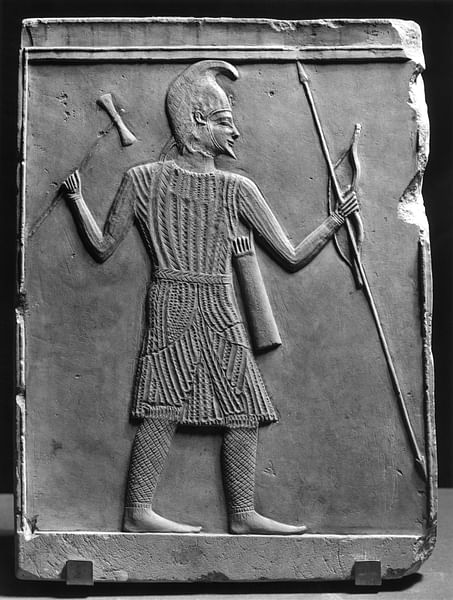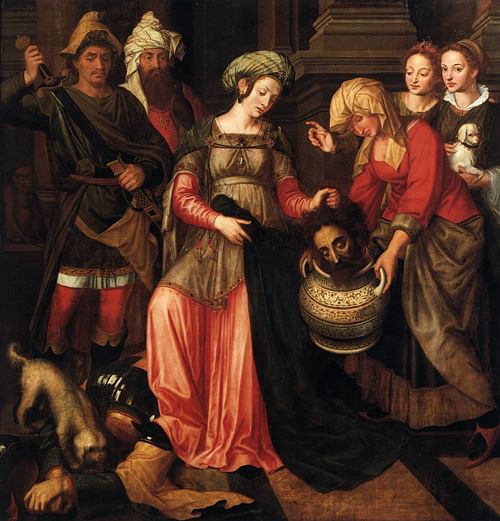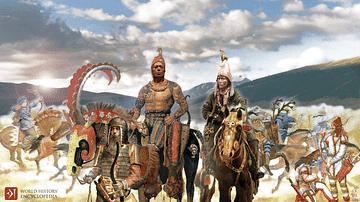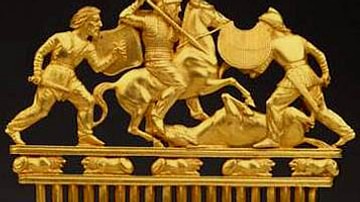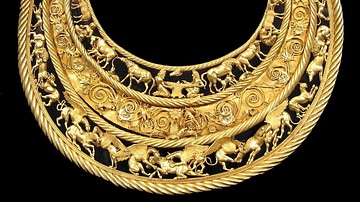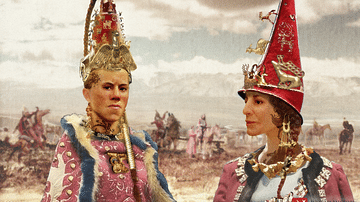
Scythian warfare used state-of-the-art recurve bows and hit-and-run tactics against set infantry formations. Working from nimble horses, Scythian warriors could unleash a cloud of lethal arrows. Known, too, for their innovative use of scale armor, they also fought hand-to-hand with shield and sword. Dominating the steppe of Central Asia between the 7th and 3rd centuries BCE, the nomadic Scythians were indeed formidable.
Weapons & Armor
For personal protection, besides using single-piece greaves to protect the shins, the Scythians were specialists in scale armor. Onto soft leather corselets, they attached iron plates in overlapping fish-scale fashion using animal tendons. The size of the plates could vary depending on the parts of the body covered. Scales around the arms and shoulders were smaller to facilitate free motion. Scale was also used to fashion helmets and to overlay wooden shields. Over time, Scythian warfare also utilized full metal helmets of the Kuban and Corinthian types.
As part of their offensive array, battle axes, maces, lances, and spears are found among their grave goods. Some of the lances discovered are around 3 meters (10 ft) in length, and the spears are 1.8 meters (6 ft). While the mace may have been more a status symbol, the use of shields and swords was basic to any infantry maneuver. Besides the plate-covered shields of their heavy cavalry, ordinary soldiers used lighter shields of woven osiers. Many of their earlier double-bladed swords were around 60 cm (2 ft) and tapered at the tip, while later 5th-century swords tapered from hilt to tip in an elongated triangle fashion.
However, the Scythian warrior's most effective weapon was the bow. Made of laminated wood, horn, sinew, and glues, it represented the apex of bow technology copied by subsequent nations like the Parthians, Mongols, and Turks. These bows were fashioned in a recurve profile to maximize the acceleration and long-range accuracy of the arrow. Being shorter, they were ideal for shooting arrows from horseback. With a common pattern of a wood core with limbs formed to curve away from the shooter, once strung, the limbs' strength and springiness were accentuated with presoaked horn laminate glued to the inside of the limbs and laminate of pounded sinew glued to the outside. A laborious process, taking up to two years to assemble, cure, and dry, the Scythian composite recurve was a valued prize, perhaps even traded to select allies like their Greek partners.
As to their performance, there is an account inscribed on a Greek grave monument in Olbia, on the Black Sea, of an Olbian named Anaxagoras winning a shooting contest by launching an arrow 521 meters (1710 ft). As the Olbians were Greek traders living in Scythian territory, it is assumed Anaxagoras' bow was acquired from the Scythians. Much later, using a composite recurve as the direct technological descendent of the Scythian bow, the Turkish Sultan Selim III (1761-1808 CE), participating in his nation's favorite pastime of flight-shooting, shot an arrow 889 meters (2916 ft). While Anaxagoras' and Selim's bows and arrows would have been modified for a particular performance, the Scythian bow as a standard archetype endured for centuries. As its pattern of manufacture and appearance remained relatively the same for hundreds of years, its ubiquitous adoption by many nations is a testament to its function and performance, especially for horse-archers.
To carry their bows and up to 75 arrows at the ready, the Scythians produced an interesting container called the gorytos. From this wide leather case, the Scythian warrior could retrieve and release up to 12 arrows a minute. With this rapid-fire technique, "given the hundreds of mounted archers who took part in most engagements, one can only imagine the hail of deadly arrows which fell among their enemies" (Chernenko, 12). Moreover, if their arrows did not hit a vital part of the body, the poison the Scythians dipped them in would finish the job. Scythicon was reputed to consist of a mixture of snake venom, decomposed snake flesh, and human serum. Arrow points dipped in this lethal concoction could, as Renate Rolle states, "cause the slightest wound to be fatal" (65). Finally, adding to its terror effect, the Scythians fashioned some of their arrows with barbed tips, making them excruciatingly difficult to remove.
Military Organization
While the Scythians organized themselves into separate tribes sharing a common culture, their military communal organization would have been an unsung part of their success. In Crimea, a golden beaker manufactured in the 4th century BCE from the Kul'-Oba kurgan shows bivouacked soldiers. While two, with spears and bows at the ready, appear to contemplate their fate in upcoming action, one demonstrates how to string a bow; another removes his comrade's tooth, while yet another bandages a fellow's hurt leg.
Another artifact in gold relief from the same kurgan demonstrates a common ritual where two warriors drink together from a horn. Such depictions reveal ways of life intended to instill a shared purpose and camaraderie among soldiers where individuals fighting for friends against foe create a united, more resilient front. Nevertheless, while Scythian loyalty between soldiers was indeed robust, group loyalty was to their tribe and chief.
Additionally, the eminent role women played in their people's military and political life was helpful to their martial success. Unprecedented until modern times, it appears some groups gained social status equal to their men. While the telling of the Amazons finds its way into modern lore, the reality of their history has long been debated. Herodotus' account tells the story of a foreign race of warrior-women coming to the shores of Scythia. As a group, they maintained their independence but eventually intermingled with a band of young Scythian men sent to them by Scythian elders. Though they spoke different languages, the two groups journeyed east to make their own tribe. Herodotus claims the Sarmatians resulted from this union and spoke a hybrid Scythian tongue. Furthermore, these warrior-women maintained their independence by following their ancient ways, often hunting on their own and warring alongside their men. They also forbade their daughters from marrying until they had killed a man in combat.
Appian validates the sovereign/warrior status of Scythian women. When describing Pompey's (106-48 BCE) triumph for defeating Mithridates VI (120-63 BCE), he includes among the procession of captured kings and generals, "female rulers of Scythia" (17.116-117) The fact Appian mentions female rulers, plural and contemporary, indicates a broad, shared, common, and cooperative status of rulership. Additionally, Herodotus' reference of Tomyris, the Scythian warrior-queen, defeating Cyrus the Great (c. 600-530 BCE) in battle centuries earlier, again suggests a tradition of female sovereignty. (1.205-214) Thus the Scythians as a whole did not hesitate to follow women warriors and rulers.
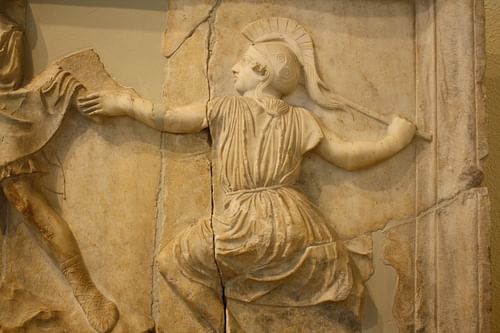
The archaeological record also indicates broad warrior, if not sovereign status for Scythian women. In 1993, in the easternmost reaches of the Scythian confederation at Ak-Alakha on the Ukok plateau in the Altai mountains, excavators found a burial site of a rich Scythian female. That she was the central figure at the site, buried with objects of status, surrounded by six saddled horses, makes it likely she was a principal elite of her people. Finally, according to Cunliffe, in Sarmatian territory, "one-fifth of the excavated warrior burials dating from the fifth to fourth centuries are female, while in Scythian territory more than forty female warrior burials are known" (219).
Strategy & Tactics
While Herodotus speaks of a 28-year period of forays outside their known environs where they defeated the Medes and were bought off by the Egyptians, their adventure was short-lived. As they pillaged and pilfered wealth, the Medes finally got them drunk and killed many of them (1.103-106). Otherwise, they were adept for a long time at protecting the homeland they knew. Their most important strategy was knowing and sticking to a territory conducive to their military style from horseback while avoiding direct engagement with set infantry formations. The geography of the open plains steppe, desert steppe, and forest-steppe expanses over which they ranged was more favorable for herding animals and travel by horse than a settled way of life involving agricultural production. Hence, their fewer urban centers and nomadic lifestyle.
Scythia's most spectacular victories were against the Persian Empire as they twice thwarted the invasion attempts of the Achaemenid Empire. When Darius I (r. 522-486 BCE) invaded Scythia, his frustration with the Scythians sticking to their strategy of non-engagement is apparent when, as Herodotus says, he taunted Idanthyrsus to stand and fight "or come to terms with your master" (4.97-142). Idanthyrsus answered, saying that was not Scythia's way of war; they would fight on their own terms.
As the Persians entered Scythian territory in 513 BCE by bridging the Danube, the Scythians denied them sustenance by burning their own fields and ruining wells. Staying a day's march ahead, as they led the Persians east above the Black Sea, the Scythians attacked Darius' foraging parties protected by their cavalry. The Scythians always won the cavalry-to-cavalry engagements, but when the Persian cavalry retreated behind infantry lines, the Scythians rode off. As these tactics went on day and night, the Scythians led the Persians deeper into allied territory, then into desolate terrain. Finally, after the Scythians circled back west, the Persians, frustrated and worn out, chose to retreat. It was at this moment the Scythians decided on a three-pronged cavalry attack. The Scythians assumed they would quickly find the Persians foraging in areas not burned, but the Persians kept to their original track instead. As the Scythians missed them, the Persians made good their escape back over the Danube. Thus with a strategy of attrition – leading the enemy deep into friendly territory, cutting vital sources, then with hit-and-run tactics and a plan of finishing their opponent off with their most formidable asset, the bow and arrows shot from horseback – the Scythians thwarted Darius' incursion.
Ultimately then, the key to their tactics and strategy were their horses. Considering they were a horse culture, specific sophisticated systems of breeding, care, training, and corralling would have been developed and employed. Once their horses were combat-ready, as they stuck to their strategy of open plains combat, avoiding nighttime raids would have been crucial. Considering Parthian-Scythian relations, that the Parthians were descendants of the Scythians and mimicked their strategy and tactics, Cassius Dio mentions they used no entrenchments and rode a long way from the field of combat when night came. (40.24) Retiring to such a distance would have made them difficult to catch, let alone find in the dark. The Scythians, likewise, would have bivouacked a safe distance from their combatants. On settling in, they would have posted sentries at select points of surveillance as their horses - with their keen sense of hearing and alertness - likely served an additional alarm.
Logistics
One of the most important means of survival, often making the difference in winning or losing a battle, is an adequate supply of food and water. Just as important is the ability to survive when sustenance is scarce. Both Cassius Dio and Plutarch speak of the ruinous effect extreme thirst had on the Roman army at the Battle of Carrhae, 53 BCE, as they fought the Parthians in a midday summer heat. When it came to surviving without water, the Parthians, like the Scythians, had other solutions. Cassius Dio writes:
By long custom they can endure the sun, which is very scorching, and they have discovered many remedies for the scantiness and difficulty of a supply of drink - a fact which is a help to them in repelling without difficulty the invaders of their land. (40.15)
The Scythians, too, were reputed to fight without food and water. Before his battle with Philip II of Macedon (r. 359-336 BCE), Ateas (429-339 BCE) boasted, "You reign over the Macedonians, men that have learned fighting, but I over the Scythians, who can fight with hunger and thirst" (Plutarch, Moralia, 3.174). Interestingly, according to Pliny, two plants first discovered by the Scythians – scythice and hippace – abate hunger and thirst. "If a person keeps [scythice] in his mouth, he will never experience hunger or thirst." Hippace, also important for the Scythians, was reputed to have a similar effect on horses. Pliny reiterates the legend that "by the aid of these two plants, the Scythians could endure hunger and thirst for twelve days" (25.43-44).
Furthermore, another survival technique long used by ancient people is the use of fat. Readily available to the Scythians from the animals they herded, a common practice for horse health is its use in a horse's diet. Descended from the extinct Turkoman horse of Seljuk fame from the Kazakh Steppe, the diet of the equally spirited Akhai-Teké is known to include (besides dates and barley) mutton fat. Additionally, the personal consumption of pemmican (fat mixed with dried meat) to forestall starvation and endure cold conditions was widely used by the North American Indians of similar latitude. Besides its long shelf life and popular inclusion in meal preparation, the rendering of fat in one of their cauldrons for select consumption and advantage in times of war was a natural option for the Scythians.
Another means of survival, especially in ancient warfare, would have been the healing of blows and cuts to the body. While effective cleansing, dressing, even suturing were known by the ancients: as Greek colonists lived among them, and the people of China and India (long adept at medicinal cures) were their neighbors, the absolute need of the Scythians to heal the wounds of their military personnel means they no doubt would have borrowed, improved, or invented effective cures. Intriguingly, as the Scythians were notably skilled in the lethality of their poisoned arrows, it was their Agari – experts in toxicology – who Mithridates made a regular part of his inner circle. Likewise, Mithridates was himself an innovator in theriac recipes (mithridatium). Yet, as Appian of Alexandria shares: after the Battle of Zela in 67 BCE, it was "the Agari who cured Mithridates of his wounds after being gravely injured by a dart below the eye and in the knee by a stone" (13.88).
Battles
Because of their military prowess, different nations often solicited the Scythians' military services. In 490 BCE, Sakā mounted archers assisted the Persians against the Greeks at the Battle of Marathon and again at the Battle of Plataea in 479 BCE. Scythian warriors were similarly among the roll call joining Darius III (r. 336-330 BCE) against Alexander the Great (356-323 BCE) at the Battle of Gaugamela in 331 BCE. Appian, the Roman historian, shows Scythian princes from the Black Sea, instrumental in Pompey's defeat of Mithridates VI in 63 BCE. Moreover, as cousins and neighbors of the Parthians, the Scythians came to Parthia's aid, when after dynastic trouble, the Parthian king Sinatruces I (r. c. 75 - 69 BCE) was installed to the throne with Scythian help. And according to Cassius Dio, the Scythians played a key role in helping Artabanus II (r. 12-38/41 CE), himself half Scythian, secure Armenia for Parthia (57.26). Tacitus supports Cassius Dio's claim showing Artabanus "collecting auxiliaries in Scythia" before joining battle (Annals, 6.44.1).
The Scythians were not just kingmakers or allies; they had spectacular wins of their own. Even during their nadir, they won two battles against the mighty Parthians, apparently over a dispute of payment. Initially, the Parthians agreed to pay the Scythians to help secure Syria from Antiochus VII (r. 138-129 BCE), ruler of the Seleucid Empire. When the Parthians won without them and then refused to pay, this sparked a Scythian revolt, ending in the death of king Phraates II (r. 132-127 BCE), which emboldened Scythian tribes in the east to defeat and kill Artabanus I (r. 127-124 BCE). At their pinnacle in 530 BCE, Tomyris, the warrior-queen of the Massagetae, consolidated Scythia's southeastern frontier by defeating and killing Cyrus the Great.
When the Persians came at them again from the north, the Scythians caused Darius the Great's (r. 522-486 BCE) retreat. This gave them the reputation of being invincible. Finally, adding to that success, Ateas (429-339 BCE), king of the Pontic Scythians, expanded Scythian interest into Thrace, establishing one of Scythia's westernmost reaches, from the Don to the Danube. But after Ateas' defeat and death at the hands of Philip II (r. 359-336 BCE) in 339 BCE, then getting caught in a trap at the river Jaxartes by Alexander the Great, the Scythians would never again recover their reputation as unconquerable.
More blows came when the Scythians tried to take over the Greeks' Black Sea trade monopoly by attacking their colonies. Coming to the Greeks' rescue at the end of the 2nd century BCE, Mithridates VI dealt the Scythians a devastating defeat, as would the Roman Empire in 63 CE when the Scythians again attacked the Chersonese. Finally, during the 4th century CE, the Scythians completely disappeared from the historical record when they were devastated by the Huns and assimilated by the Goths. But at their zenith, thanks to their horsemanship and military acumen, Scythian territorial expanse, ranging from the Hungarian Plain in the west to the Greater Altai Mountains in the east, covered an astonishing 2.4 million km² (1.5 million mi²) of land.

